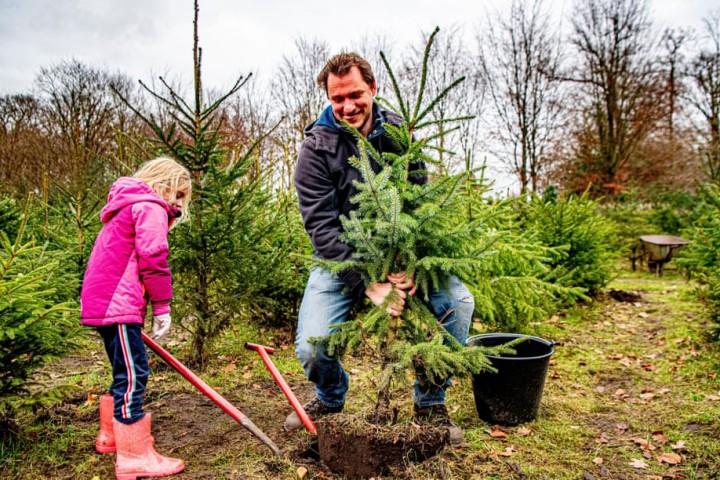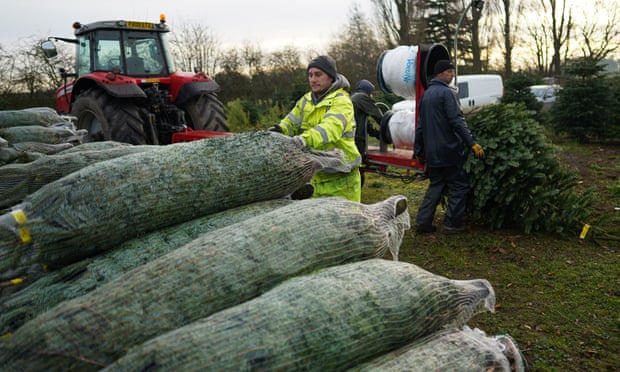Real or fake: which Christmas tree is most sustainable?

Green-fingered consumers might be better buying a potted tree that can be used for several Christmases. Photograph: Robin Utrecht/Rex/Shutterstock
It’s the annual dilemma. Do you buy an artificial tree that will give years of service, or do you stick with a real one that will be discarded on 6 January?
This year British households are expected to buy as many as 8m real Christmas trees, but with growing concern about the climate crisis, many consumers are wondering if this is the greenest option.
“Choosing the most sustainable Christmas tree will vary depending on circumstance,” says the Friends of the Earth senior sustainability analyst, Clare Oxborrow. “For those who already own an artificial tree, it’s best to keep on using that over buying a new one. By reusing the same decorations year on year, unnecessary waste can also be kept to a minimum.”
According to the Carbon Trust, a 6.5ft artificial tree is responsible for about 40kg of greenhouse gas emissions – which means you need to reuse it for about 10 Christmases to keep its environmental impact lower than buying a real tree every year, depending on the materials used in the fake tree.
Around two-thirds of an artificial tree’s carbon footprint is the plastic it is made from. If you are keen to buy one you could also look out for one made out of recycled materials or a pre-owned one, it suggests.
If it is a real tree you want, the British Christmas Tree Growers Association (BCTGA) advises you opt for one grown nearby. Its website, bctga.co.uk, has a useful directory to help you find a company where you live.
“Buy a tree from a local grower who has actually grown it on their property,” suggests the BCTGA chairman, Hans Alexandersen. “If they’re grown in some faraway place and are being transported from A to B, you’re putting a lot of mileage on that tree.”
In recent years the supply of domestically grown Christmas trees has increased, making it easier to avoid imports. The most popular choice is the Nordmann fir, which is much admired for its thick, bushy branches and soft needles that are slower to drop than a traditional Norway spruce.

For those who already own an artificial tree, it’s best to keep on using that over buying a new one, experts say. Photograph: Matthew Ashmore/Alamy
Renting a tree has become a popular alternative for people who care about their environmental impact but prefer to have a real one at home,says Oxborrow. “Once returned to the vendor after the festive period, trees are replanted so that they can be rented out again next year,” she says.
Advertisement
However, she suggests the green fingered explore potted options. “Those with a dab hand for gardening might be better off buying a potted tree and looking after it the whole year round, so it continues to pay off well after its first use.”
While rental services can be marginally cheaper than buying a tree outright, Alexandersen is sceptical of a model that sees them clock up extra miles on the road or perish anyway if they are not cared for properly. If a tree is going to be planted outside afterwards it needs to be kept away from heat sources and stay indoors for no longer than a fortnight.
His own company, Hans Christmas Andersen, which has farms in Surrey and Kent, cuts down about a 10th of its 800,000 trees each year, with each one felled replaced with a new tree. “We don’t go into a forest and cut trees out of that,” he says. “We have planted these trees for cutting and the environment they are creating for wildlife is amazing.” The BCTGA advises consumers to wait as long as they can before buying what is a “fresh” product.
Tree prices vary around the country but against a backdrop of rising living costs, Alexandersen says shoppers should expect to pay about 5% more this year, as growers recoup higher fertiliser, fuel and labour costs.
“We have incurred quite a lot of expenses during the year,” he says. On his farms the price of a 6ft Nordmann fir or Norway spruce has increased by £5 to £60 and £35 respectively. “With Brexit and the virus, things have become a little bit more difficult for us to get and we have had to pay more and that also includes on the labour side.”
How you dispose of a real tree is actually more significant than where it comes from or how you got it home. If it ends up in landfill the impact on the environment is much worse because of the methane released during decomposition.
Most local authorities now offer a collection service for real trees which they shred and use on gardens and parks. If that is not an option some companies will come to your house and grind it into mulch for you. If you have a shredder you can do it yourself.
Real, fake or rent? How the costs stack up

A fresh 6ft Nordmann fir can cost anywhere from about £35 to £70. Photograph: Ian Forsyth/Getty Images
Fresh trees
Costs vary considerably from provider to provider. In Kent, Watts Farm advertises a 6ft locally grown Nordman fir at £48, while at Exe Valley Christmas Trees you will pay £50, plus a delivery charge if you want it brought to your door. The Christmas Forest, which runs sites around London and does deliveries, is charging £70 for a 6ft tree of the same type.
Among large retailers, at Homebase a 6-7ft Nordman fir is being advertised for £36.75, while Wilko has the same sized tree on its website at £54.
Rented trees
At Primrose Vale Farm Shop in Gloucestershire the cost of renting a 6ft tree is £45, plus a refundable deposit of £15, for the period from the first week of December to 9 January. If you want the same tree back next year, the deposit will be held. Christmas on the Hill in north London has sold out of big trees, but can rent you a 3-footer for £36, plus £4 to rent a watering saucer and a £30 deposit. Again you can have the same tree back year after year – so one day it should reach 6ft.
Artificial trees
You can buy a 6ft plastic tree from B&Q for £22, or spend as much as £184 in the same shop for one that includes 400 LED bulbs with eight light settings. Most retailers offer a selection of different designs across a similar range of prices. Bear in mind, if you are going to use it for the next decade you probably want a classic green tree, rather than something quirky that might become dated.
Hilary Osborne

